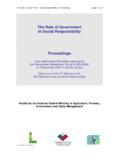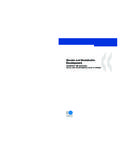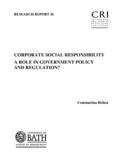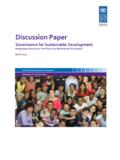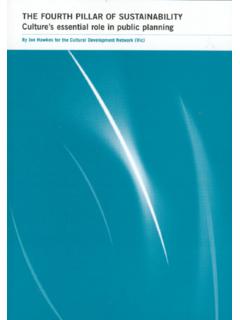Transcription of UNITED NATIONS DEVELOPMENT PROGRAMME Civil Society’s Role ...
1 Civil society s Role in Poverty and Social Impact Analyses: A Resource Guide and Toolkit for EngagementUNITED NATIONS DEVELOPMENT PROGRAMME3 Civil society S ROLE IN POVERTY AND SOCIAL IMPACT ANALYSES: A RESOURCE GUIDE AND TOOLKIT FOR ENGAGEMENT list of acronymslist of acronymsADMARC Agricultural DEVELOPMENT and Marketing Corp. (Malawi parastatal organization)CBO community-based organizationCSO Civil society organizationDFID Department for International DEVELOPMENT (UK)EURODAD European Network for Debt and DEVELOPMENT (coalition of European NGOs)GTZ German Agency for Technical Cooperation (Germany)IFAD International Fund for Agricultural DevelopmentIMF International Monetary FundINGO international non-government organizationM&E monitoring and evaluationMDG Millennium DEVELOPMENT GoalNGO non-governmental organizationODI Overseas DEVELOPMENT Institute (UK NGO)PRGF Poverty Reduction and Growth Facility (IMF)PRSC Poverty Reduction Support Credit (WB)
2 PRSP Poverty Reduction Strategy Paper (IMF/WB)PSIA Poverty and Social Impact AnalysisSEA strategic environmental assessmentSIA social impact assessmentTIPS Tools for Institutional, Political and Social Analysis (UNDP/WB)UNDP UNITED NATIONS DEVELOPMENT ProgrammeUNCT UNITED NATIONS country teamWB World Banksection 01 introduction & overview Preface ..10 Introduction ..14 Resource guide and toolkit overview ..22section 02 tools & approaches for Civil society engagement in psiA processes Getting started some general points & steps ..26 Civil society capacity ..35 Principal tools for Civil society organisations ..41 Partnership as an approach for Civil society engagement.
3 45section 03 a framework for Civil society engagement & empowerment Presenting a framework for PSIA processes ..48 Key questions to ask ..51 Overcoming challenges ..52 The political side of engagement a look at power relationships ..54 Guidance on carrying out PSIA activities ..57section 04 conclusions: finding a way forward 62section 05 resources List of PSIAs conducted ..68 Glossary ..69 Bibliography ..72section 06 appendices 755 Civil society S ROLE IN POVERTY AND SOCIAL IMPACT ANALYSES: A TOOLKIT FOR ENGAGEMENT contents6 UNITED NATIONS DEVELOPMENT PROGRAMME boxesbOx 01: Frequently asked questions (FAQs) ..12bOx 02: Poverty and Social Impact Analyses (PSIAs).
4 15bOx 03: Case study: The privatization of ADMARC in Malawi ..17bOx 04: Case study: Civil society participation in PSIAs Examples from Armenia, Ghana and Honduras ..18bOx 05: Practical arguments for CSO engagement in policy processes ..19bOx 06: Tajikistan: An example of a PSIA lacking CSO involvement ..20bOx 07: Different CSO approaches to engaging in the Malawi ADMARC PSIA ..21bOx 08: What Civil society can add to PSIA processes ..22bOx 09: Some guidance on tools to support a PSIA 10: Case study: The PSIA process in Bolivia and Uganda ..34bOx 11: Case study: The Environmental Foundation Ltd. in Sri Lanka ..40bOx 12: Conducting a livelihoods analysis in a PSIA.
5 44bOx 13: The functions of CSO networks ..45tablesTAb LE 01: Key elements of the PSIA process ..16 TAb LE 02: roles and responsibilities for PSIA engagement: A typology ..37 TAb LE 03: Possible roles & responsibilities for different stakeholders ..38 TAb LE 04: Capacity building for CSO engagement in the PSIA process ..39 TAb LE 05: Principal tools for Civil society engagement in PSIAs ..42 TAb LE 06: Methods for assessing the social consequences of policy and DEVELOPMENT ..43 TAb LE 07: Entry points for overcoming challenges to engagement ..536 UNITED NATIONS DEVELOPMENT PROGRAMME boxes and tables7 Civil society S ROLE IN POVERTY AND SOCIAL IMPACT ANALYSES: A RESOURCE GUIDE AND TOOLKIT FOR ENGAGEMENT toolsTOOL 01: Checklist of general types of Impact A rapid audit.
6 29 TOOL 02: Poverty diagnosis form: Getting a snapshot of the situation ..31 TOOL 03: Problem diagnosis matrix An example ..32diagramsDIAGRAM 01: Achieving more effective CSO engagement in PSIAs: A recommended framework ..50 DIAGRAM 02: Power cube A means of understanding different forms of political space ..55appendicesAPPENDIx 01: Rapid impact audit checklist: An example from Morocco ..78 APPENDIx 02: Poverty diagnosis form: Taking a snapshot of the situation ..80 APPENDIx 03: Problem diagnosis: Using a problem tree ..81 APPENDIx 04: Stakeholder analysis ..83 APPENDIx 0 5: Gender analysis ..85 APPENDIx 0 6: Institutional analysis.
7 87 APPENDIx 07: Power analysis ..88 APPENDIx 08: The sustainable livelihoods framework: An example from the Tanzania 0 9: Participatory research tools ..93 APPENDIx 10: Social impact assessment ..95 APPENDIx 11: Poverty analysis ..96 APPENDIx 12: Quantitative methods A summary ..97 APPENDIx 13: The policy cycle: A diagram of key components and actors ..98 APPENDIx 14: CSO action on PSIA: A diagram from Tanzania ..99 APPENDIx 15: A case study of Vernile: CSO engagement in a hypothetical country PSIA Process ..100 APPENDIx 1 6: A case study exercise: CSO engagement in a PSIA ..105 APPENDIx 1 7: Running a workshop: A sample agenda.
8 107tools, diagrams, and appendices01introduction & overviewPrefaceBackground and acknowledgementsIntroductionWhat are PSIAs?Why should Civil society be interested in PSIAs?How should Civil society be involved in PSIA processes?Resource guide and toolkit overviewObjectives and intended audienceOrganization of the guide The Wonderful Children of Malawi Photography by Karl H. Mueller10 UNITED NATIONS DEVELOPMENT PROGRAMME01 | introduction & overviewPrefaceThe success or failure of any poverty reduction PROGRAMME depends crucially on local conditions. But the people who understand such conditions best can be shut out from the PROGRAMME -design process, which is often dominated by policy-makers who may live outside targeted locales, international specialists and other members of the donor community.
9 This resource guide and toolkit is UNDP s attempt to redress this imbalance, to help members of Civil society participate effectively in policy decisions that affect not only the poorest members of their community but also local economic conditions in policy-making process in particular is the focus of this guide: the process of undertaking a Poverty and Social Impact Analysis (PSIA). That is because PSIAs, which are used not just by UNDP but also by the World Bank, IMF and many bilateral donors, are becoming a standard means for setting the agenda for a targeted locale arriving at the broad policy prescriptions that influence local DEVELOPMENT efforts for years.
10 A growing number of programmes and initiatives that gain the support of the international donor community today can be traced to policies that were first formulated in a PSIA. In practical, user-friendly terms, this toolkit describes capacity-building ideas and techniques that members of Civil society can use to become engaged in any PSIA as the success of any poverty-reduction PROGRAMME depends on local conditions, so it is with the techniques described in this guide, the first of its kind produced by UNDP. Some tools and ideas may be useful to you; others may not. We at UNDP intend this guide to function as a living document , subject to change based on feedback we receive from prospective DEVELOPMENT partners like you.










